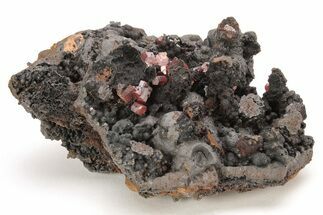This Specimen has been sold.
Anatase Crystal On Adularia - Hardangervidda, Norway
This gorgeous specimen contains an association metallic anatase and adularia (variety of orthoclase). The crystals formed from a schist matrix, collected from Hardangervidda, Norway. The anatase crystal measures .6" long.
There appears to be a repaired crack just beneath the anatase crystal. The specimen has been mounted onto an acrylic display base.
There appears to be a repaired crack just beneath the anatase crystal. The specimen has been mounted onto an acrylic display base.
About Anatase
Anatase is a mineral composed of titanium dioxide that typically forms dipyramidal crystals, although variations can occur with mineral clumping. Four-pointed, X-shaped anatase crystals, while rare, have been found and are known as "X-shaped penetration twins". Horizontal striations can be seen across most anatase mineral faces and most crystals end in points, or with variations of flattening on each end. It can be found in a variety of colors, from browns and reds to greens and pinks, and can be colorless in very rare cases. However, it is most commonly black or other very dark colors due to impurities.
Anatase is a mineral composed of titanium dioxide that typically forms dipyramidal crystals, although variations can occur with mineral clumping. Four-pointed, X-shaped anatase crystals, while rare, have been found and are known as "X-shaped penetration twins". Horizontal striations can be seen across most anatase mineral faces and most crystals end in points, or with variations of flattening on each end. It can be found in a variety of colors, from browns and reds to greens and pinks, and can be colorless in very rare cases. However, it is most commonly black or other very dark colors due to impurities.
Adularia is a variety of feldspar that had the chemical formula KAlSi3O8. It is found most often as colorless to white aggregations within metamorphic rock, usually within cavities of crystalline schists. Adularia crystals are commonly twinned, glassy and prismatic in structure, and in some cases they display opalescent characteristics. Adularia is very similar to orthoclase, even bearing the same chemical formula, but it has a different crystalline structure and reacts differently to various tests. Its name comes from its type locality: the Adula Massif in the Alps of south-central Switzerland.
SPECIES
Anatase & Orthoclase var. Adularia
LOCATION
Hardangervidda, Norway
SIZE
Entire specimen 1.4 x 1.3", .6" anatase crystal
CATEGORY
ITEM
#177353
 Reviews
Reviews
















